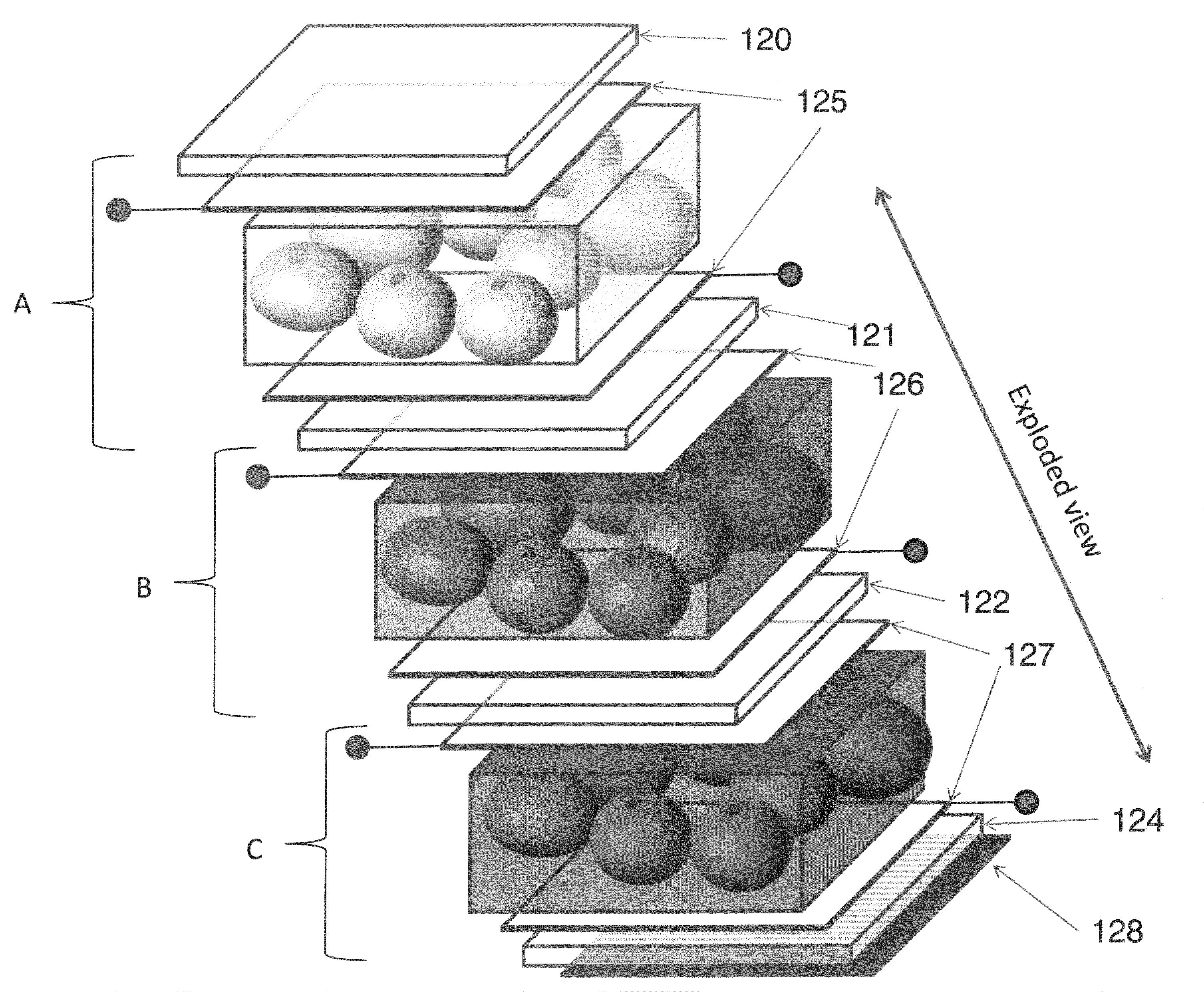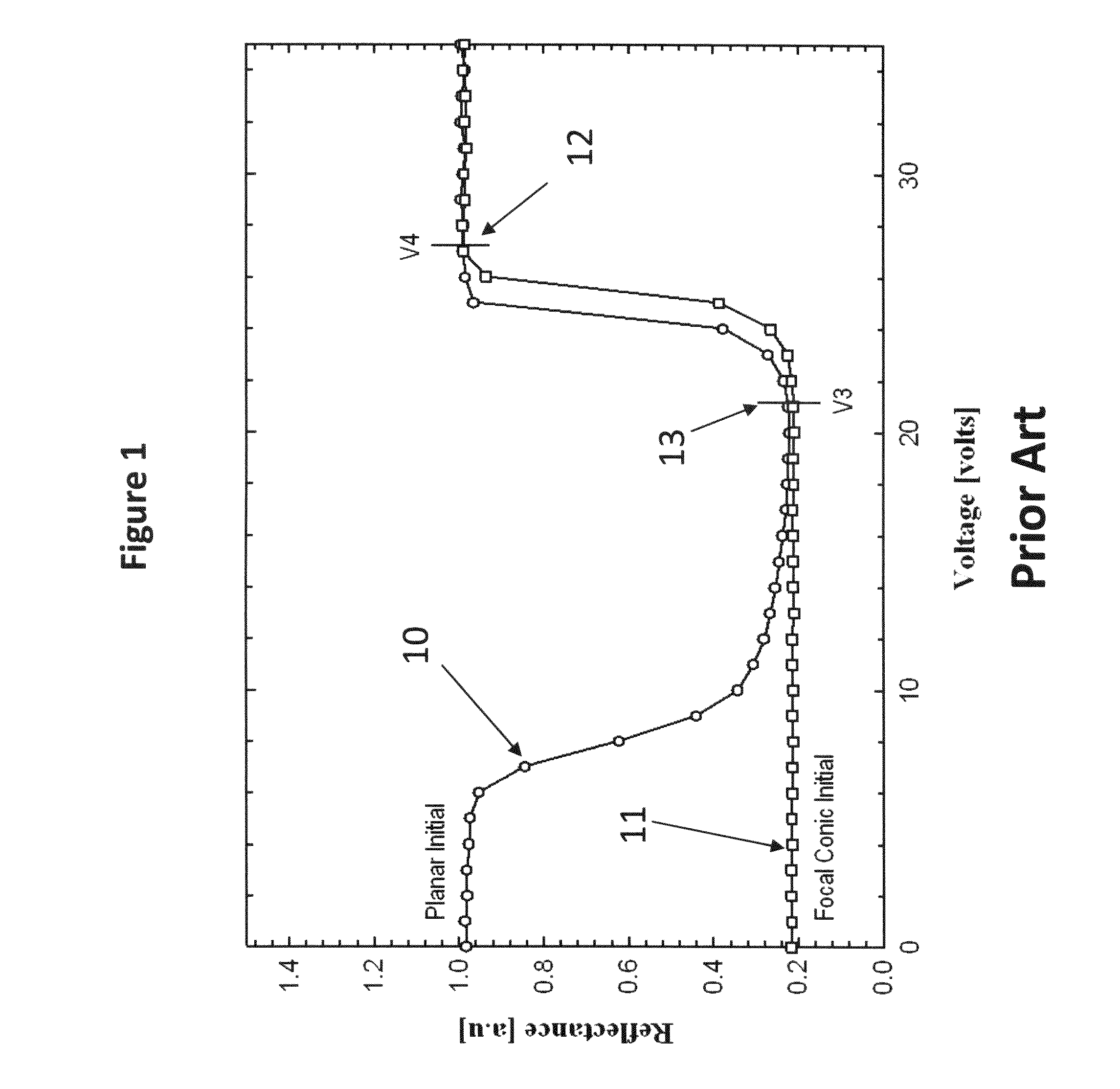Electronic skin having uniform gray scale reflectivity
a technology of gray scale reflectivity and electrooptic devices, applied in optics, non-linear optics, instruments, etc., can solve the problems of reducing the sensitivity of gray scale to display imperfections, affecting the sensitivity of prior art gray scale drive schemes, and displaying imperfections in the conductive layer forming electrodes. , to achieve the effect of avoiding gray scale discontinuities, and reducing the sensitivity of gray levels
- Summary
- Abstract
- Description
- Claims
- Application Information
AI Technical Summary
Benefits of technology
Problems solved by technology
Method used
Image
Examples
example 1
[0064]Levels of gray are levels of brightness as they are reduced from the maximum brightness exhibited by the planar texture of a particular electronic skin. In order to demonstrate the difference between uniform and non-uniform levels of gray, a bistable cholesteric cell illustrated in FIG. 4 was constructed. The glass cell was constructed using two 5.5×5.5 inch glass substrates, each 0.55 mm thick with ITO transparent conductors. The glass substrates were of unpolished glass exhibiting an expected roughness and not a perfectly smooth surface. The cell gap spacing was set by the use of glass spacers with an average size of 9 microns. However, because of the roughness of the substrates the cell gap was expected to have imperfections in cell gap thickness by as much as 0.4 μm which is typical for the use of unpolished glass. The glass cell was filled with a cholesteric liquid crystal KLC-23, a Kent Displays, Inc. proprietary mixture of a nematic liquid crystal with a large dielectri...
example 2
[0066]Electrooptic response curves which are a plot of the reflectance of the cell versus the rms voltage of a pulse are experimentally achieved for a bistable cholesteric cell for various pulse widths as shown in FIG. 6. While acquiring each of the data points, the cell was observed visually with the eye to determine if the cell exhibited a uniform or non-uniform gray level. The glass cell was constructed using two 2×2 inch glass substrates, each 1.0 mm thick with ITO transparent conductors. The glass substrates were of unpolished glass exhibiting an expected roughness and not a perfectly smooth surface. The cell gap spacing was set by the use of glass spacers with an average size of 5.0 microns. However, because of the roughness of the substrates the cell gap was expected to have imperfections in cell gap thickness by as much as 0.4 μm expected for unpolished glass. The glass cell was filled with the same cholesteric liquid crystal KLC-23, (Kent Displays, Inc.) as used in Example ...
example 3
[0068]In this example, while not wanting to be bound by theory, we estimated the variation of the cell gap distance from the data of FIG. 6 based on the assumption it is due to the variation in the surface roughness of the unpolished glass surface of the substrates from which the cell was formed. The premise of this example is that the slopes of the curves in FIG. 6 determine the sensitivity of gray levels to the imperfections in the bistable cholesteric cell. This is supported by the observation that the solid data points (points exhibiting uniform gray levels) all terminate on the left side of each curve at about the same slope. This value is given by the ratio (ΔR / ΔV)max where ΔR is the change in Reflectance and ΔV is the corresponding change in Voltage at a point on the curve. From the curves it is found that (ΔR / ΔV)max≈0.02. If the non-uniformity is due to variations in cell gap then one obtains:
(ΔR / ΔV)max=(ΔR) / E(Δd)≈0.02. Eq. 1
[0069]Where E is the electric field and Δd is the...
PUM
| Property | Measurement | Unit |
|---|---|---|
| Electrical conductivity | aaaaa | aaaaa |
| Color | aaaaa | aaaaa |
| Flexibility | aaaaa | aaaaa |
Abstract
Description
Claims
Application Information
 Login to View More
Login to View More - R&D
- Intellectual Property
- Life Sciences
- Materials
- Tech Scout
- Unparalleled Data Quality
- Higher Quality Content
- 60% Fewer Hallucinations
Browse by: Latest US Patents, China's latest patents, Technical Efficacy Thesaurus, Application Domain, Technology Topic, Popular Technical Reports.
© 2025 PatSnap. All rights reserved.Legal|Privacy policy|Modern Slavery Act Transparency Statement|Sitemap|About US| Contact US: help@patsnap.com



